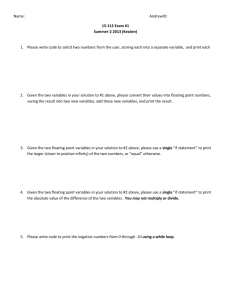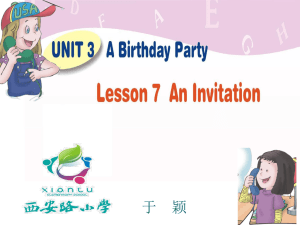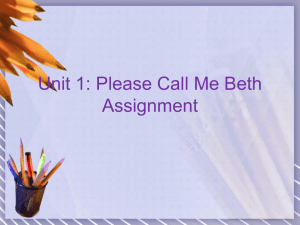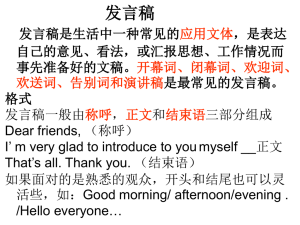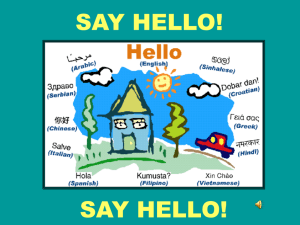Lesson plan – Primary
advertisement
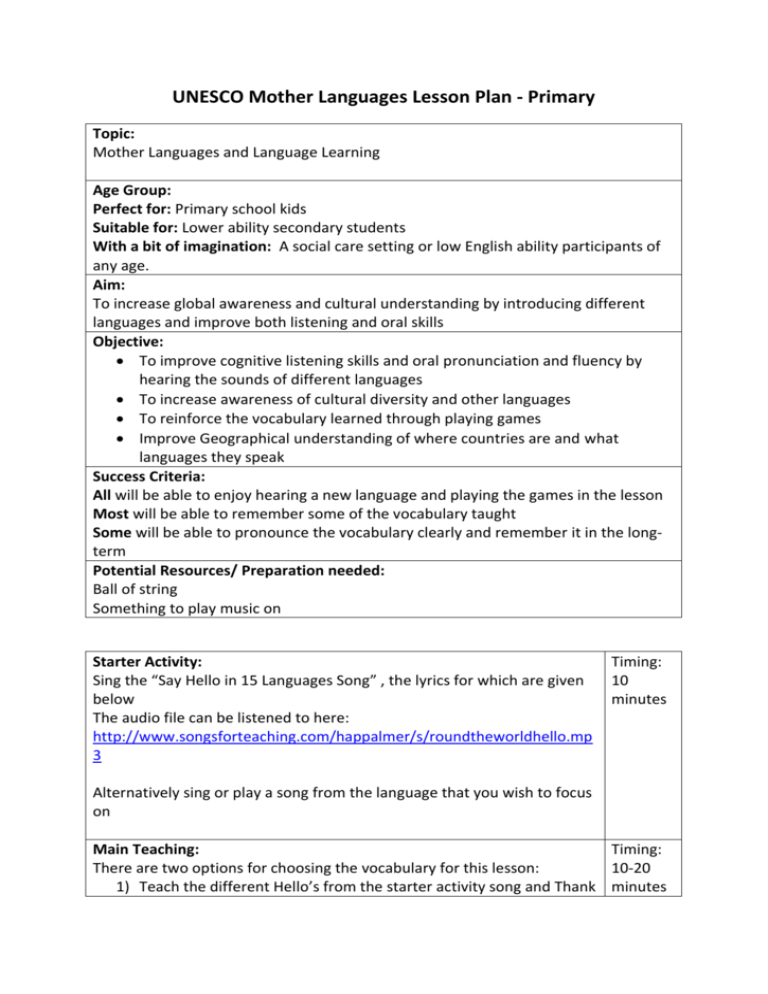
UNESCO Mother Languages Lesson Plan - Primary Topic: Mother Languages and Language Learning Age Group: Perfect for: Primary school kids Suitable for: Lower ability secondary students With a bit of imagination: A social care setting or low English ability participants of any age. Aim: To increase global awareness and cultural understanding by introducing different languages and improve both listening and oral skills Objective: To improve cognitive listening skills and oral pronunciation and fluency by hearing the sounds of different languages To increase awareness of cultural diversity and other languages To reinforce the vocabulary learned through playing games Improve Geographical understanding of where countries are and what languages they speak Success Criteria: All will be able to enjoy hearing a new language and playing the games in the lesson Most will be able to remember some of the vocabulary taught Some will be able to pronounce the vocabulary clearly and remember it in the longterm Potential Resources/ Preparation needed: Ball of string Something to play music on Starter Activity: Sing the “Say Hello in 15 Languages Song” , the lyrics for which are given below The audio file can be listened to here: http://www.songsforteaching.com/happalmer/s/roundtheworldhello.mp 3 Timing: 10 minutes Alternatively sing or play a song from the language that you wish to focus on Main Teaching: Timing: There are two options for choosing the vocabulary for this lesson: 10-20 1) Teach the different Hello’s from the starter activity song and Thank minutes you in one other language 2) Teach Hello and Thank you in your chosen language. However be flexible and creative in choosing additional/ other vocabulary to teach as the activities are highly adaptable and the words used can be substituted easily. Counting from 1-10 is a flexible option. If there are other dialects of the local language that participants know attempt to include this in your lesson Spend some time using a variety of the following drilling techniques to reinforce the vocabulary that you teach in your chosen language before playing the activities. Choral Drilling – All repeating the words together Modelling Speed- First saying the word very slowly to practice pronunciation of each part, then the whole word, then slowly building up to natural speed Finger stressing- Getting everyone to count out the syllables of the words on their fingers Open Pairs – Have two participants from other sides of the room practice the vocabulary together while the others listen Closed Pairs - Have participants practice the vocabulary privately in pairs and go around listening Progressive- Have the participants practice the vocabulary with each other one by one in a line, this could be a greeting, a questions and answer or even just counting up numbers Development Activities: (Group or Individuals): Each of these games could be played for 10 minutes or more *Who said hello A child is chosen to sit on a chair with his/her back to the class. The teacher then points to another child who says hello in the target language to the child sitting on the chair, e.g. Bonjour. The child on the chair then has to identify the person who said the greeting. As the game goes on have the children use silly voices to make it harder/ more fun. When the child sitting on the chair has identified 5 children they can be rewarded with a sticker. *Hello again The class sits in a circle in the hall. One child walks around the circle and chooses another child by tapping him/her on the shoulder. The two children shake hands and say hello 3 times using the target language. They then race in opposite directions around the circle. When they meet Timing: 20-40 minutes halfway they repeat their greetings and then continue racing to the empty space left by the child who was tapped on the shoulder. The first to sit in the empty space is the winner. The other child walks around the circle and chooses a new child to say hello to. *Pass the ball of string The children sit in a circle. One child holds the end of a ball of string, calls out a friends name and throws the ball of string to that friend. The child who gets the ball of string says thank you in the target language. The second child then holds a piece of string and passes the ball to another child, and so on. The children end up making a web pattern with the string. The teacher then winds up the ball of string saying thank you to each child. *Placing Languages on the World Map. The aim of this lesson is to discuss who speaks which language across the world. Have a list of cutouts (e.g. Russian) of the languages from the “Say hello in 15 Languages” song and ask them where in the world they think the language is spoken. Use the map of major world languages provided below and have the participants try to stick the cut outs to the right country on the world map. If possible have a sound snippet/audio recording of each language that they can listen to and then ask them to stick the cut-outs on the world map. Play the audio recordings so the student becomes familiar with the sound of the language. Plenary: Have participants say, write down and draw a picture of their favourite hello in another language Timing: 5 minutes Homework: have participants greet you in the language of their favourite hello each morning for the rest of the week Timing: n/a Say Hello in 15 Languages "Hello" in Different LanguagesVocabulary: hola, hejsan, jambo, bonjour, privet, ni hao, shalom, salaam, annyong, konnichiwa, sawubona, prijatno, namaste, dzien dobry, aloha. Activity: This is a call and response song about the ways people say "hello" in different languages. Children listen to each word or phrase then sing it back like an echo. As a lead up activity, it is helpful to break the words into syllables and slowly say each syllable one at a time. This is an excellent activity for helping children develop phonemic awareness, or the ability to hear the sounds of language. Hola, hola, (OH-lah) says hello in Spanish Hejsan, hejsan, (HEY-sun) that's the word in Swedish Jambo, jambo, (JAHM-boh) says it in Swahili 'Round and 'round the world we go with ways to say hello Bonjour, bonjour, (bohn-zhoor) says hello in French Privet, privet, (preev-YET) that's the word in Russian Ni hao, ni hao, (nee how) says it in Chinese 'Round and 'round the world we go with ways to say hello There are oh, so, many friendly ways Every language has a word or phrase Shalom, shalom, (sha-lome) says hello in Hebrew Salaam, salaam in (sah-lahm) Arabic and Persian Annyong , annyong, (ahn-yohng) says it in Korean 'Round and 'round the world we go with ways to say hello Konnichiwa, konnichiwa, (Ko-nee-chee-wa) says hello in Japanese Sawubona, sawubona, (saw-oo-BOH-nah) that's the word in Zulu Prijatno, prijatno, (pree-yat-no) says it in Macedonian 'Round and 'round the world we go with ways to say hello There are oh, so, many friendly ways Every language has a word or phrase Namaste, namaste, (nah-MUS-stay) says hello in Hindi Dzien dobry, dzien dobry, (JEEN-do-bri) that's the word in Polish Aloha, aloha, says it in Hawaiian 'Round and 'round the world we go with ways to say hello Follow up: Sing this song using greetings from other languages. Here are some possibilities: Mingala ba (Burmese) Bula (Fijian) Halito (Choctaw) Dobar dan (Croatian) Talofa (Samoan) Bawoni (Yoruba) Guten Tag (German) Poolah (Setswana) Zdravo (Serbian).

